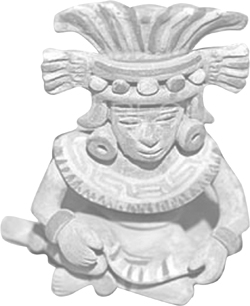[Page 1] The Goddess Chalchihuitlicue, found in the Valley of Mexico, 1300-1500 AD (stone), Aztec / Muse de l'Homme, Paris, France / Bridgeman Art Library. 
By now you have heard a lot about Java and are anxious to start writing Java programs. The first part of the book is a stepping stone that will prepare you to embark on the journey of learning Java. You will begin to know Java and will develop fundamental programming skills. Specifically, you will learn how to write simple Java programs with primitive data types, control statements, methods , and arrays.
[Page 2] Prerequisites for Part 1
This book does not require any prior programming experience, nor any mathematics, other than elementary high school algebra and basic computer skills such as using Windows, Internet Explorer, and Microsoft Word.
You may cover the concept and simple examples of recursive programming in 19.119.3 in Chapter 19, "Recursion," after Chapter 5, "Methods."
You may cover Chapter 23, "Algorithm Efficiency and Sorting," after Chapter 6, "Arrays." Two simple sorting algorithms are introduced in Chapter 6. Chapter 23 introduces several advanced sorting algorithms.

| | Chapter 1 Introduction to Computers, Programs, and Java | |
| | Chapter 2 Primitive Data Types and Operations | |
| | Chapter 3 Selection Statements | |
[Page 3] Chapter 1. Introduction to Computers, Programs, and Java
Mayan God Shel, Mexico. Photographer: Philip Coblentz. Courtesy Brand X Pictures.

[Page 4] 1.1. Introduction
You use word processors to write documents, Web browsers to explore the Internet, and email programs to send email over the Internet. Word processors, browsers, and email programs are all examples of software that runs on computers. Software is developed using programming languages. There are many programming languages. So why Java? The answer is that Java enables users to develop and deploy applications on the Internet for servers, desktop computers, and small hand-held devices. The future of computing is being profoundly influenced by the Internet, and Java promises to remain a big part of that future. Java is the Internet programming language.
You are about to begin an exciting journey, learning a powerful programming language. Before the journey, it is helpful to review computer basics, programs, and operating systems, and to become familiar with number systems. You may skip the review in 1.21.4 if you are familiar with such terms as CPU, memory, disks, operating systems, and programming languages. You may also skip 1.5 and use it as reference when you have questions regarding binary and hexadecimal numbers.

